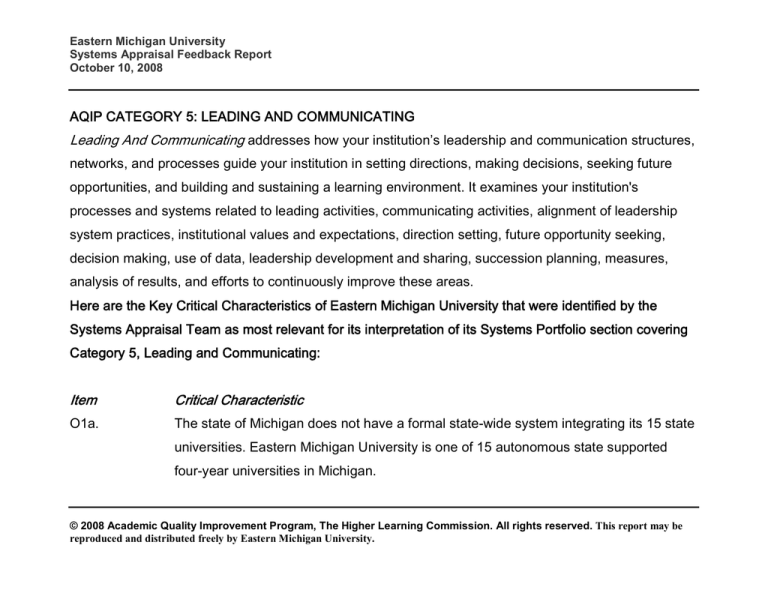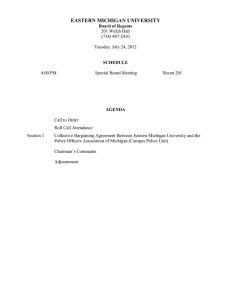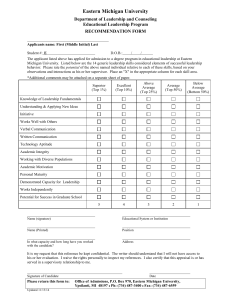
Eastern Michigan University Systems Appraisal Feedback Report October 10, 2008 AQIP CATEGORY 5: LEADING AND COMMUNICATING
Leading And Communicating addresses how your institution’s leadership and communication structures,
networks, and processes guide your institution in setting directions, making decisions, seeking future
opportunities, and building and sustaining a learning environment. It examines your institution's
processes and systems related to leading activities, communicating activities, alignment of leadership
system practices, institutional values and expectations, direction setting, future opportunity seeking,
decision making, use of data, leadership development and sharing, succession planning, measures,
analysis of results, and efforts to continuously improve these areas.
Here are the Key Critical Characteristics of Eastern Michigan University that were identified by the
Systems Appraisal Team as most relevant for its interpretation of its Systems Portfolio section covering
Category 5, Leading and Communicating:
Item
Critical Characteristic
O1a.
The state of Michigan does not have a formal state-wide system integrating its 15 state
universities. Eastern Michigan University is one of 15 autonomous state supported
four-year universities in Michigan.
© 2008 Academic Quality Improvement Program, The Higher Learning Commission. All rights reserved. This report may be reproduced and distributed freely by Eastern Michigan University. Eastern Michigan University Systems Appraisal Feedback Report October 10, 2008 O1b.
Eastern Michigan University has experienced decreases in state funding, resulting in
nearly 30% of institutional revenues now coming from state appropriations. As a result,
the institution is becoming more dependent on student tuition and fees.
O1c.
The past five years have been turbulent in terms of campus leadership, with three
campus presidents during that period. The current president has served for less than 3
months.
O1d.
Eastern Michigan University has embraced a commitment to contribute to the local
community in its core principles and strategic directions, demonstrated by more than
25,000 hours of student volunteer community service annually.
O1e.
Eastern Michigan University is currently engaged in a thoughtful, evidence-based
approach to campus-wide planning
O1f.
Eastern Michigan University is guided by a mission that emphasizes excellence in
teaching, applied research, and artistic expression
O1g.
Eastern Michigan University has adopted five core principles and four strategic
directions that guide decision making, which emphasize learning, engagement with the
community, and diversity and multiculturalism.
© 2008 Academic Quality Improvement Program, The Higher Learning Commission. All rights reserved. This report may be reproduced and distributed freely by Eastern Michigan University. Eastern Michigan University Systems Appraisal Feedback Report October 10, 2008 O4a.
Eastern Michigan University collaborates through accreditation agencies, businesses,
centers and institutions, targeted industry grants, research grants and agreements, non
profits, advisory boards and steering committees, community colleges, and K-12
districts.
O5a.
Most of Eastern Michigan University’s employees are represented by unions. The
nonunion employees include administrative/professional, confidential clerical
employees and coaches.
O6e.
Since a high-publicity on-campus homicide in December 2007, security has been a
very high priority. Physical upgrades and safety programs have been implemented.
Here are what the Systems Appraisal Team identified as Eastern Michigan University’s most important
strengths and opportunities for improvement relating to processes encompassed by Category 5, Leading
and Communicating.
Item
S/O
5P1
O
Comment
The University has aligned its leadership and communication around its culture
(e.g., collective bargaining) and structures (integrated committees). However, it
© 2008 Academic Quality Improvement Program, The Higher Learning Commission. All rights reserved. This report may be reproduced and distributed freely by Eastern Michigan University. Eastern Michigan University Systems Appraisal Feedback Report October 10, 2008 has not identified processes by which directions are aligned with the institutional
mission, vision and values, or which consciously seek to foster high performance,
individual development and initiative, organizational learning or innovation.
Leadership sets directions, while “considering” other key stakeholders and their
“appropriate input.” The University may benefit by exploring leadership processes
that more consciously address the mission and values and which systematically
focus on high performance, initiative and improvement.
5P2
O
While Eastern Michigan University leaders are active participants in various
activities; the University does not identify systematic processes by which leaders
seek out future opportunities. While faculty do collaborate with advisory boards in
efforts to identify opportunities to enhance the learning environment, methods for
identifying external challenges or opportunities for institutional leadership (e.g.
systematic environmental scanning) are not identified. In light of rapid changes in
its geographic area and transitions in leadership, the University could enhance its
future through regular processes for identifying future opportunities.
© 2008 Academic Quality Improvement Program, The Higher Learning Commission. All rights reserved. This report may be reproduced and distributed freely by Eastern Michigan University. Eastern Michigan University Systems Appraisal Feedback Report October 10, 2008 5P3
O
Processes for gathering information prior to decision making, and using
information to make decisions, are briefly described. Information appears to be
obtained from stakeholder teams or committees in various ways, depending on
the issue and circumstances. The uses of information in decision making are not
identified. The University has adopted a decision-making process, IDEA,
modeled on the classic PDCA technique, but has not demonstrated its use or
evaluated its effectiveness. It is also noted that information-gathering techniques
are guided by collective-bargaining agreements, which may impede the ability of
the University to incorporate other, more effective processes. The current efforts
to explore a balanced scorecard management process may help the University
enlarge and systematize its methods for informing decision making.
5P4
O
Eastern Michigan University identifies several areas on which key results are
regularly monitored, largely based on enrollment-related information. However,
systematic processes by which information is used in decision making are not
described. A new initiative to adopt a Balanced Scorecard approach is noted as a
© 2008 Academic Quality Improvement Program, The Higher Learning Commission. All rights reserved. This report may be reproduced and distributed freely by Eastern Michigan University. Eastern Michigan University Systems Appraisal Feedback Report October 10, 2008 method by which the University will formalize the tracking of key performance
indicators. Decision making based on these indicators is intended to follow.
5P5
S
Communication processes for the University employ a wide range of methods for
sharing information, both vertically and horizontally, through publications and
regularly scheduled meetings of committees and councils. The processes are
embedded in collective-bargaining agreements, but it is unclear whether these
methods effectively foster communication in upward, downward, and horizontal
directions. The University may improve its communications by insuring that
information and input flows up, as well as down, and travels across institutional
areas.
5P6
O
University leaders plan to communicate a shared mission, vision, and values and
high performance expectations through the University’s new strategic planning
process (Figure 8.2). The process, based on the longstanding IDEA (aka PDCA)
model, is intended to promote continuous improvement at the University level
and align its planning and budget-development with the mission and values. At
this stage, it is unclear the extent to which this model will communicate the
© 2008 Academic Quality Improvement Program, The Higher Learning Commission. All rights reserved. This report may be reproduced and distributed freely by Eastern Michigan University. Eastern Michigan University Systems Appraisal Feedback Report October 10, 2008 values of improvement, learning, ethics and equity throughout the organization.
Specific processes by which this communication will occur are as yet not noted.
Instituting these communication processes at all levels of the University can help
to insure that these values are regularly communicated.
5P7
S
Eastern Michigan University offers a broad range of professional development
opportunities, which include a number that foster leadership development. These
include on- and off-campus programs, including an Organizational
Transformation plan that will address various levels of leadership. Moving faculty
into administrative positions also provides leadership growth opportunities. As
the administration moves forward in these leadership development programs, the
University should also consider programs that foster leadership among groups
less represented in current leadership.
5P8
O
In light of the University’s recent experience with frequent leadership turnover, it
is important that methods for developing leadership and effective succession are
established. A new effort to expand leadership development has recently begun
and will spread through the organization over time. Leadership succession,
© 2008 Academic Quality Improvement Program, The Higher Learning Commission. All rights reserved. This report may be reproduced and distributed freely by Eastern Michigan University. Eastern Michigan University Systems Appraisal Feedback Report October 10, 2008 however, remains a challenge, as no processes have been identified. Efforts to
insure both leadership development and succession are vital to the University’s
plans to institutionalize best practices and continuous improvement.
5R1-5R2
OO
No results for measurement of leadership and communication are currently
available. No comparative measures with other institutions are provided.
4I1
O
Given the absence of results, no improvements have been identified at this time.
© 2008 Academic Quality Improvement Program, The Higher Learning Commission. All rights reserved. This report may be reproduced and distributed freely by Eastern Michigan University.



